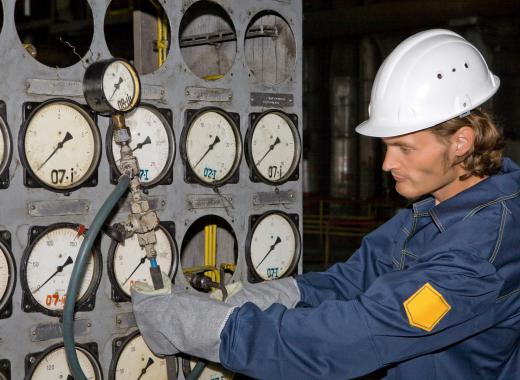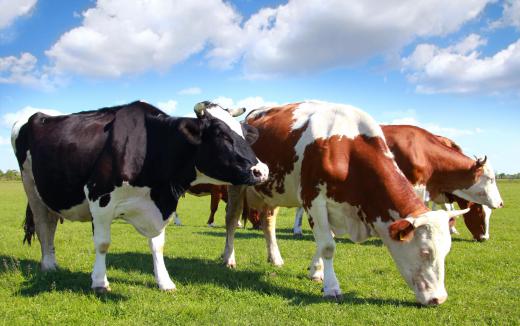What is a Biogas Plant?
A biogas plant is an anaerobic digester that produces biogas from animal wastes or energy crops. Energy crops are cheap crops grown for the purpose of biofuels, rather than food. Biofuels are liquid, gaseous, or solid fuel made from live or recently dead organic material known as biomass, as opposed to fossil fuels, which are composed of ancient biological materials. Biogas is a type of biofuel created via anaerobic, or oxygen-free, digestion of organic matter by bacteria. A biogas plant is composed of a digester and a gas holder.
The digester is an airtight container in which the waste is dumped and decomposed, and the gas holder is a tank that harnesses the gases emitted by the slurry. Bacteria within the digester tank breaks down the waste and, as it decomposes, gases such as carbon monoxide, methane, hydrogen, and nitrogen, are released. Through a pressurized system, the gas holder conducts the flow of these gases upward into a hole in its drum. The hole is specially designed to allow gases to pass freely into the holder while prohibiting any gases from escaping back into the digester. In a controlled environment, the gases are later combusted, or reacted, with oxygen to create an energy source for such processes as heating and vehicle propulsion.

Construction of a biogas plant may vary depending on the amount of gas needed, the amount of waste at hand, and whether the digester is designed for batch feeding or continuous feeding. Batch feeding systems use mostly solid wastes that are added to the tank in installments, and continuous feeding models feed mostly liquids to the digester. A biogas plant may be constructed either above or below ground, with advantages and disadvantages to both models. An above ground biogas plant is easier to maintain and benefits from solar heating, but takes more care in construction because it must be built to handle the internal pressure of the digester. A below ground biogas plant is cheaper to construct and easier to feed, but is more difficult to maintain.

To facilitate fast decomposition with optimal gas production, digesters are often kept between the temperatures of 29°C and 41°C (84.2°F-105.8°F). In an attempt to neutralize the slurry, more acidic carbon dioxide, which is a desired gas, will be created. The slurry within the tank must also be frequently stirred to prevent a hard crust from forming on top of the waste. A crust can trap the gases within the slurry and impede the machinery’s ability to harness the gases.

Biogas is increasingly preferred to fossil fuels, or fuels made from ancient organic matter like coal or oil. Carbon, in small amounts, is a vital component of a healthy atmosphere, but becomes problematic when too much is added into circulation. The carbon contained in fossil fuels has been buried for such a long time that is no longer part of the carbon cycle. When it is released through burning of fossil fuels, it raises the carbon concentration. Biogas, however, comes from live or recently dead organisms whose carbon content is still within the cycle, so burning these fuels does less to upset the carbon concentration in the atmosphere.
In addition to carbon output, biogas fuel is often preferred to fossil fuels because it is a low cost, renewable source of energy and it uses otherwise wasted materials. Biogas is also a valuable energy source for developing nations, as it can be produced in small-scale sites. Biogas fuel, however, also has its critics. Some argue that energy crops detract from food agriculture and will create a global food shortage. Biofuels may also cause deforestation, water pollution, soil erosion, and a negative economic impact on oil producing nations.
AS FEATURED ON:
AS FEATURED ON:













Discussion Comments
It's a shame that the trends of the transition to bio-gas technology does not extend to Eastern Europe. Despite the presence of such large companies biogas as Zorg this type of energy earning isn't popular in post-soviet countries.
Last year I watched a show on discovery channel where a group of people made their own bio gas. They actually made bio gas to power an old broken down box truck. It was interesting to learn how they made the bio gas.
The colonists heated wood chips in what looked like a double boiler. The wood chips began to char, releasing a combustible gas, which the colonists then fed into the engine of the truck. The wood gasification process was one of the most ingenious things I have seen.
@ aplenty- I go to U. Iowa, and we have converted one of our coal plants into a biomass and biogas capable power plant. The plant can process either coal or biomass and waste to use as fuel. U Iowa now produces far less pollution and carbon emissions than it did before the plant conversion was completed.
My sister goes to Middlebury College in Vermont, and the school just opened a 12 million dollar biogas production plant. The plant will replace half of the fuel oil the school burns each year (about 1 million gallons) by wood gasification. The school sources the woodchips used in the plant from within a 75-mile radius, and the plant reduces the schools carbon footprint by 40 percent.
After my sister told me about this, I read an article in the Christian Science Monitor about the plant. Eventually the school plans to replace half of the wood fuel they use with fast growing willow shrubs that the college plans to grow on its property. This will be even more sustainable since the school will grow and harvest the willow crops on site, the plants have a high density per acre, and the plants require virtually no fertilizer.
Post your comments